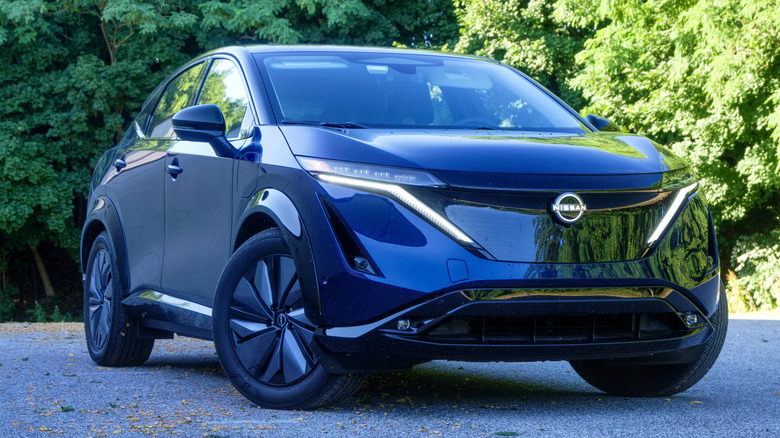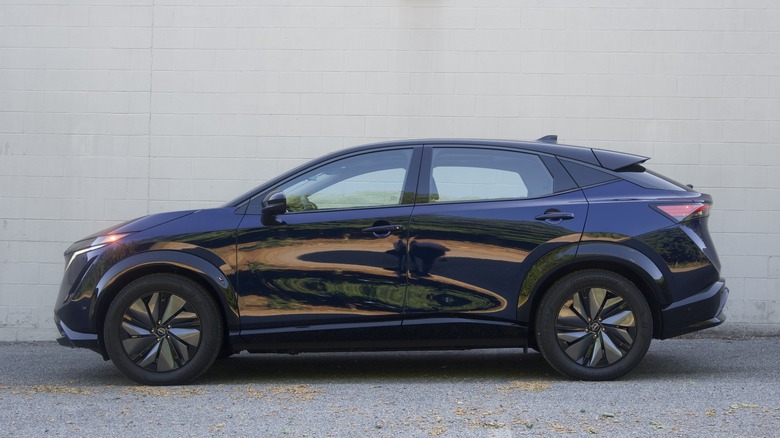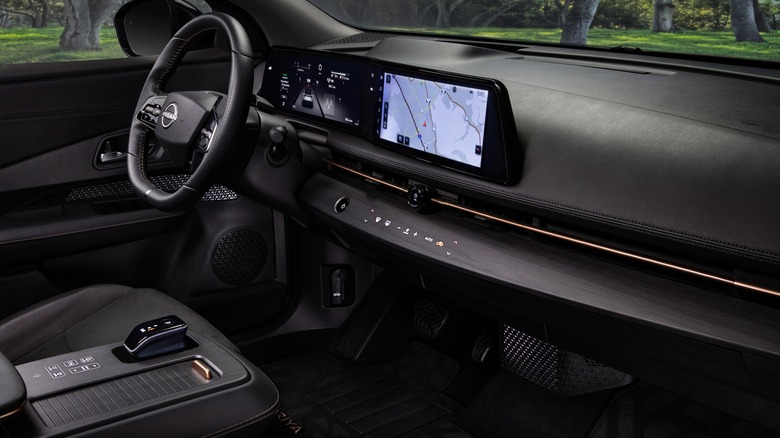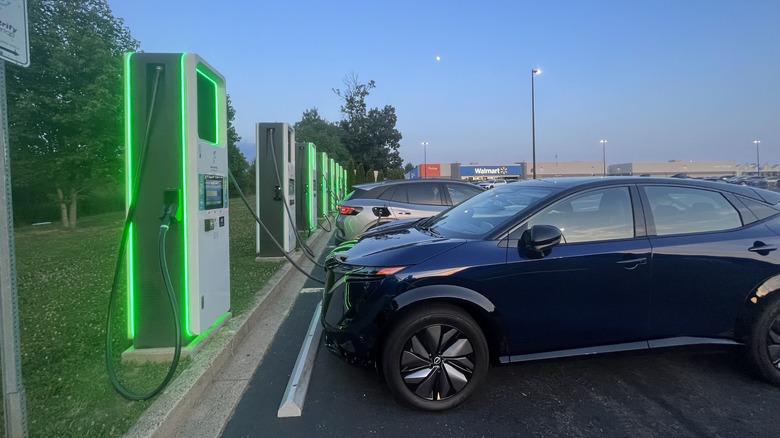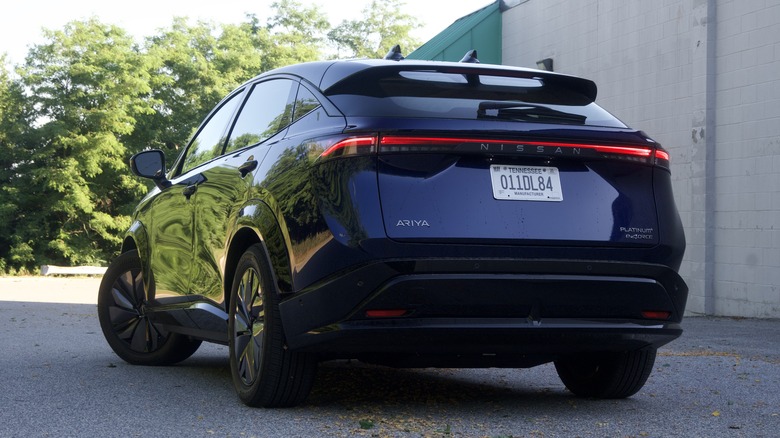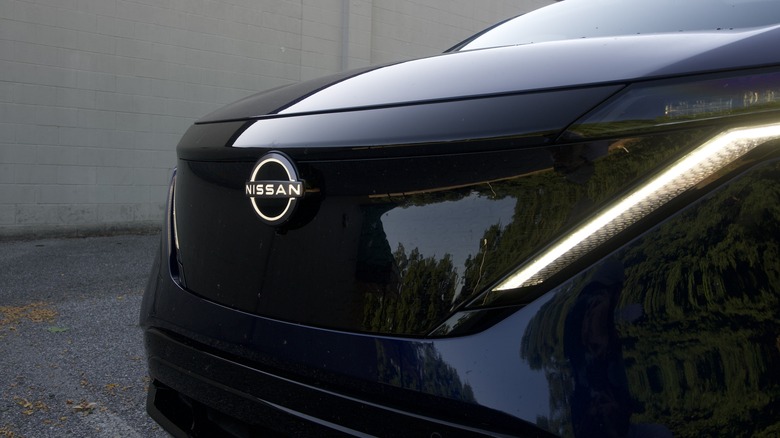2024 Nissan Ariya Review: Stuck In Leaf's Shadow
- Great paint color
- Styling grows on you
- Quiet
- Thoroughly dull to drive
- Doesn't stand out amid rival EVs
- Cabin puts style over practicality
Nissan changed the game for electric cars and more or less popularized the concept of battery powered personal cars with the Nissan Leaf a number of years ago. Tesla, Kia, Hyundai, and the Big Three might be fighting for EV supremacy now, but the Leaf had to crawl before the Tesla Model Y could walk. Enter the Nissan Ariya, the automaker's new player in the cutthroat crossover electric SUV market. While the Nissan Leaf has somewhat faded in popularity compared to the late, great Chevy Bolt or the Tesla Model 3, does the Ariya have what it takes to give the EV crown back to the original battery connoisseurs?
With the smash hit that was the Leaf way back in yesteryear, how does the Ariya stack up? Despite the Leaf's small size, it's a giant on the mainstream EV timeline and the Ariya has huge environmentally conscious sandals to fill. Nissan's newest EV might be striking to look at, but what's it like to live with?
An odd electric duck
Style is subjective, but from the outset, I can't help but think that the Ariya is an odd looking vehicle. It's not quite SUV shaped as it doesn't sit very high off the ground, yet it's too tall to be a sedan or wagon (Nissan's own paperwork classifies it as a "small station wagon"). It has kind of a minivan-like profile, if you squint really hard. Sea-mammal definitely comes to mind. This orca-like vehicle was finished in the appropriately named Ocean Blue Pearl and Black Diamond Pearl two-tone paint job.
On a technical end, the Nissan Ariya is a lot like its competing brethren. The Ariya Platinum+ e-4ORCE (yes, it's really called that) I was tasked with evaluation was equipped with a 91 kilowatt hour battery, that Nissan says has a usable capacity of 87 kilowatt hours. Range is an estimated 267 miles and I found that to be mostly accurate if you drove very conservatively. It has two electric motors that generate a somewhat hefty 389 horsepower and 442 pound-feet of torque. It's a positively heavy 5,507 pounds.
Not doing itself any favors
The interior, much like the exterior, is trying very hard to stand out with futuristic lighting accents and minimalism to the extreme. Nissan probably wanted to make the Ariya interior seem high-class and sophisticated. At best, it's boring, at worst it's trying to scream "look at me." On a practicality end, the minimalism isn't doing it much favors, but more on that later.
From behind the wheel, the Ariya is a perfectly adequate vehicle to drive and can even approach nice when it wants to, but it's mostly a snoozefest that struggles to set itself apart from other EV crossovers. The styling may turn people away in favor of the Tesla Model Y; the ride quality is worse than the Mach-E; and it's the polar opposite of the cool and chiseled Hyundai Ioniq 5. It doesn't stand out in any conceivable way, and while the Leaf could count on a relatively captive audience with minimal alternatives to choose from, the Ariya faces a very different marketplace.
The Nappa leather interior was certainly nice, and it wasn't at all torturous to drive for me or the passengers I ferried. Yet the cabin made it seem like there wasn't anywhere to easily put your phone, keys, or wallet. The center console opened up with the press of a button, but its motors were too slow and its dimensions too small to be useful: I just ended up using the cupholders for those tchotchkes. The integrated wireless charging pad didn't work reliably at charging my phone, but did do an exceptional job at making it really hot.
Charging the Ariya
While the weather was better than the last time I tested an EV, making the battery behave more reliably, it wasn't any less painful. There are still no DC fast chargers within an hour of where I lived. One night, with a scant 15% battery, I went out in search of a Level 2 charger. With 5% remaining, I found one in a grocery store parking lot, and sat there charging for a full 2 hours to only add 10% of charge. That night I relented, and parked the Ariya in a friend's garage to charge off of a wall socket.
You can't really rely on public charging with any electric car, and the specific charging locales of York County, Pennsylvania shouldn't be counted against Nissan specifically. Public charging was scarce, but from a strict usability standard, it was hassle free. Charging in my friend's garage wasn't painful either, although I wish the Ariya's infotainment system was a little better with charging data, apart from basics like how much time was left.
As a bit of a side note to the charging experience, every EV seems to have its own ceremonial dance to allow the charging apparatus to "talk" to the car. In the case with an Electrify America charger, it required plugging into the car, waiting for the charger to wake up and figure out what's happening, unplugging from the car, which required pressing the unlock button twice on the Ariya's key fob, and then plugging in again to pay and start charging. For the first time EV owner, none of this routine is clearly explained.
Is it a good deal
Now to tally up the price. The Ariya isn't egregiously expensive, but it isn't cheap either. The base model Ariya starts at $39,590, certainly aggressive when compared to the $44,990 Tesla Model Y and $39,995 Ford Mach-E, though the cheapest Nissan's 216 miles of estimated range essentially eliminates it from any rational competition. The model I drove, the 2024 Ariya Platinum+ e-4orce with all-wheel drive starts at $54,190.
As for options, it was painted in the rather attractive "Deep Ocean Pearl," which added $350. An exterior ground lighting package tacks on $750, throw in a destination charge of $1,390, and you end up with $56,680 at the end.
Nearly $60,000 for an EV crossover isn't inexpensive, especially considering the Ariya's lack of clear reasons to distinguish it over the competition. Eye-catching paint and a sleek exterior only go so far. Your neighbors might think the Ariya parked in your driveway looks nice, but you're the one who actually has to live with it, drive it, and pay for it.
2024 Nissan Ariya Verdict
I didn't really love or hate driving the Ariya. It was smooth, quiet, and quick, but then so is every other EV crossover on the market. The range was firmly in the "meh" category, and the stylized interior didn't do anything to sway me in its favor. Indeed in some place it was, such as was the case with storage, working against itself.
The old Proverb reads that "pride goes before the fall," and it's tough not to see that being the case with Nissan. It rocked the world with the Leaf well over a decade ago, proving that EVs could be really viable cars. Problem is, it has coasted by in the face of competition the Leaf itself inspired, and has promptly fallen on its face with the Ariya. Unless you get a good deal on one, I can't see any real reason to buy an Ariya over a Tesla Model Y, Ford Mach-E, Kia EV6, or Hyundai Ioniq. It's too expensive to be a good deal, too weird to be useful, and it's primary saving grace is Nissan's ability to mix a good paint color.
The first generation Nissan Leaf pushed electric vehicles into the mainstream, yet the Ariya is barely a blip on the radar in the vast sea of notable EVs. Where the original Leaf was notable for being an affordable, practical, and straightforward car, Nissan's followup just doesn't deliver on that original electrified magic.
